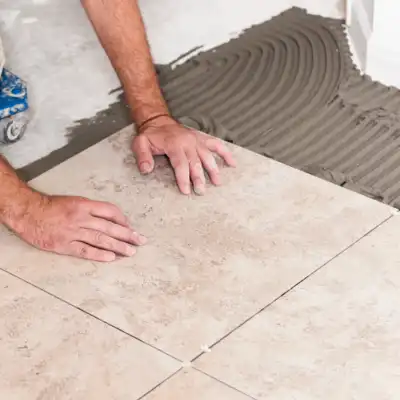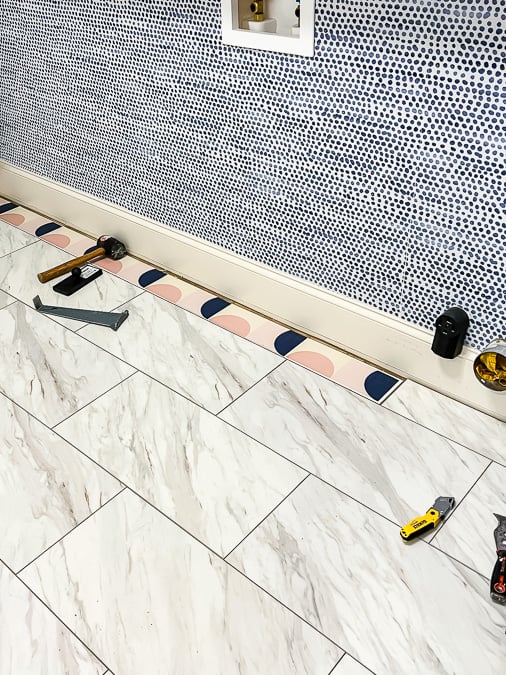Beautify Your Room: Professional Tile Installation Austin, Texas
Beautify Your Room: Professional Tile Installation Austin, Texas
Blog Article
Discover the Keys to Perfect Floor Tile Installation Every Time
Understanding the art of ceramic tile installment includes a collection of precise actions and methods that, when executed properly, can result in a refined and smooth coating. By comprehending the keys behind each action, you can make sure that your floor tile installation not just fulfills but surpasses your assumptions.
Correct Surface Prep Work
Effective ceramic tile installment hinges considerably on precise surface preparation to make sure a perfect result. Before laying ceramic tiles, it is necessary to examine the substrate's problem extensively. The surface area needs to be clean, completely dry, and structurally seem to stop future concerns such as loosened tiles or cracked grout. Any existing floor covering material, adhesives, or sealers need to be removed to develop a consistent base for the new floor tiles.
To ensure proper adhesion, it is advised to roughen smooth surface areas through sanding or scarifying. In addition, applying a guide can boost bonding between the ceramic tile and the substratum adhesive. Uneven surface areas must be leveled utilizing a self-leveling compound to avoid lippage and ensure a smooth coating.
Moreover, inspecting for possible resources of dampness is crucial, as excess dampness can cause mold development and damage the floor tiles with time. Utilizing a wetness barrier or waterproofing membrane layer in damp areas like cooking areas or restrooms is necessary to protect the tiles from water damage. By carefully preparing the surface area prior to ceramic tile installation, one can produce a long lasting and visually attractive tiled area that will certainly stand the test of time.

Choosing the Right Adhesive
Choosing the appropriate adhesive is a critical step in ensuring the effective installation of tiles. The kind of sticky you pick will rely on various elements such as the kind of floor tile, the substratum material, and the place of the installation. There are various sorts of adhesives readily available on the market, including thin-set mortar, mastic, and epoxy.

Epoxy adhesives are exceptionally resilient and water-resistant, making them optimal for locations susceptible to moisture such as shower rooms or kitchen areas. They are also suitable for installing glass or steel ceramic tiles. When picking a sticky, make certain to follow the supplier's recommendations and take into consideration the specific requirements of your floor tile installation task.
Precision Reducing Techniques
One of the most common devices utilized for precision cutting in tile installment is the tile cutter. Floor tile cutters come in various kinds, consisting of hand-operated floor tile cutters, electrical damp saws, and portable ceramic tile cutters. Manual tile cutters are appropriate for straight cuts on ceramic and porcelain tiles, offering exact and tidy edges.
Moreover, using a tile nipper enables comprehensive cuts and forming around obstacles or irregular forms. Wet floor tile saws geared up with ruby blades are superb for making rounded cuts, intermediaries for components, or complex styles. Furthermore, using devices like floor tile scribes or glass cutters can assist in racking up and breaking ceramic tiles with accuracy. By mastering these accuracy cutting techniques, floor tile installers can guarantee a professional finish and a visually appealing cause their floor tile tasks.

Cement Application Tips
When transitioning from accuracy reducing methods to grout application in ceramic tile installation, focus to information and technique is vital for achieving a flawless surface. Grout serves not just as a practical element that fills up the gaps between ceramic tiles however likewise plays a considerable function in the total aesthetic of the setup. To guarantee a successful grout application, start by selecting the proper type and color of grout that click to read enhances the floor tiles. Mix the grout according to the supplier's guidelines, guaranteeing a smooth and lump-free uniformity.
When using cement, job in little sections each time to avoid it from drying out too swiftly. Use a rubber float to press the grout into the joints at a 45-degree angle, making sure full coverage original site and compacting the product. Once the grout is applied, use a damp sponge to clean the ceramic tiles, making certain not to get rid of grout from the joints. Ultimately, buff the ceramic tiles with a dry cloth to eliminate any haze and achieve a sleek surface. Complying with these cement application suggestions will certainly lead to an expertly installed ceramic tile surface area that improves the elegance of any area.
Finishing Touches and Maintenance
To complete the tile setup job properly, interest to detail throughout the ending up touches and normal upkeep is important. After the cement has actually dried out and the floor tiles are securely in place, the final steps involve making sure that all edges are correctly sealed.
Normal upkeep is key to maintaining the beauty and capability of your tiled surfaces. An easy routine of sweeping or vacuuming complied with by wiping with a mild cleanser can aid maintain your ceramic tiles looking excellent (tile installation austin). For locations that are frequently exposed to dampness, such as kitchen areas or bathrooms, routine resealing of grout lines is recommended to stop mold and mildew development
Final Thought
Finally, attaining best floor tile setup whenever needs interest to information and proper techniques. By concentrating on surface area preparation, picking the correct adhesive, utilizing accuracy reducing approaches, using cement meticulously, and completed with interest to detail, you can guarantee a professional-looking result. Keep in mind to adhere to these actions and keep your floor tiles routinely to extend their lifespan and keep them looking their finest.
One of the most common tools made use of for precision cutting in floor tile installation is the ceramic tile cutter. Tile cutters come in numerous types, consisting of manual tile cutters, electrical damp saws, and handheld ceramic tile cutters. Hand-operated ceramic tile cutters are ideal for straight cuts on directory ceramic and porcelain floor tiles, providing accurate and clean sides. In addition, making use of devices like tile scribes or glass cutters can help in racking up and breaking ceramic tiles with accuracy. By grasping these accuracy reducing methods, tile installers can make sure a specialist coating and a visually attractive outcome in their ceramic tile jobs.
Report this page